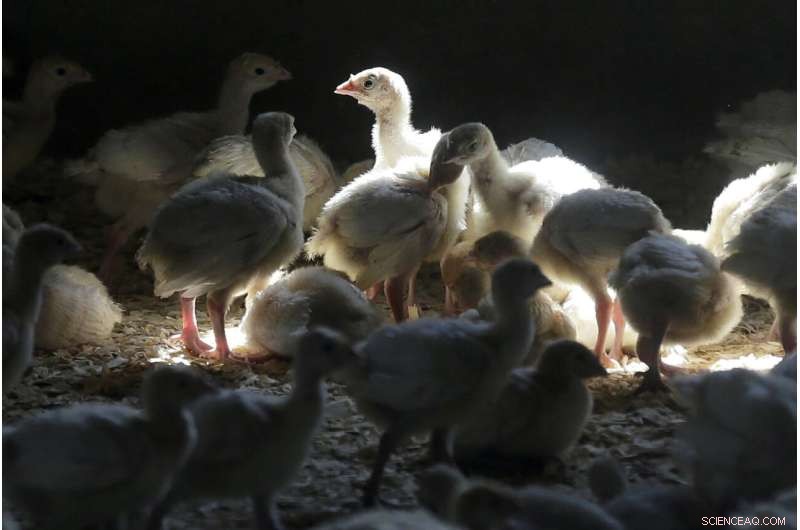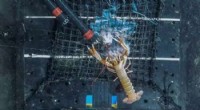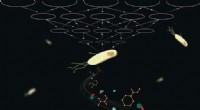
Wetenschap
griezelige vraag bij vogelgriep:hoe dood je miljoenen pluimvee

Kalkoenen staan in een schuur op een kalkoenboerderij in de buurt van Manson, Iowa op 10 augustus 2015. Wanneer gevallen van vogelgriep worden gevonden op pluimveebedrijven, handelen ambtenaren snel om alle vogels in die kudde te slachten, zelfs als het in de miljoenen loopt, maar dieren welzijnsgroepen zeggen dat hun methoden onmenselijk zijn. Credit:AP Photo/Charlie Neibergall, Bestand
De verspreiding van een dodelijke vogelgriep voor pluimvee roept de griezelige vraag op hoe boerderijen erin slagen om snel miljoenen kippen en kalkoenen te doden en van de hand te doen.
Het is een hele klus waar boerderijen in het hele land steeds meer mee te maken krijgen, aangezien het aantal gedode pluimvee in de afgelopen twee maanden is gestegen tot meer dan 24 miljoen, met uitbraken die bijna elke dag worden gemeld. Sommige boerderijen hebben op één locatie meer dan 5 miljoen kippen moeten doden met als doel de vogels binnen 24 uur te vernietigen om de verspreiding van de ziekte te beperken en dierenleed te voorkomen.
"Hoe sneller we ter plaatse kunnen komen en de vogels die ter plaatse blijven, kunnen ontvolken, hoe beter", zei Beth Thompson, dierenarts van de staat Minnesota.
De uitbraak is de grootste sinds 2015, toen producenten meer dan 50 miljoen vogels moesten doden. Dit jaar zijn er dit jaar gevallen geweest in 24 staten, waarbij Iowa het zwaarst werd getroffen met ongeveer 13 miljoen gedode kippen en kalkoenen. Andere staten met omvangrijke uitbraken zijn Minnesota, Wisconsin, South Dakota en Indiana.
Boerderijen die worden geconfronteerd met de noodzaak om zoveel vogels te doden, wenden zich tot aanbevelingen van de American Veterinary Medical Association. Zelfs als het methoden heeft ontwikkeld om het pluimvee snel te doden, erkent de vereniging dat haar technieken "misschien niet garanderen dat de sterfgevallen waarmee de dieren worden geconfronteerd pijnloos en pijnvrij zijn." Dierenartsen en functionarissen van het Amerikaanse ministerie van landbouw houden doorgaans ook toezicht op het proces.
Een van de voorkeursmethoden is het sproeien van blusschuim op waterbasis over vogels terwijl ze in een schuur over de grond zwerven. Dat schuim doodt de dieren door hun luchttoevoer af te sluiten.
Wanneer schuim niet werkt omdat vogels in kooien boven de grond zitten of het te koud is, raadt de USDA aan om schuren af te sluiten en kooldioxide naar binnen te leiden, eerst de vogels bewusteloos te maken en ze uiteindelijk te doden.
Als een van deze methoden niet werkt omdat er geen apparatuur of werknemers beschikbaar zijn, of wanneer de grootte van een koppel te groot is, zei de vereniging dat een laatste redmiddel een techniek is die ventilatie-uitschakeling wordt genoemd. In that scenario, farmers stop airflow into barns, which raises temperatures to levels at which the animals die. The USDA and the veterinary association recommend that farmers add additional heat or carbon dioxide to barns to speed up the process and limit suffering by the animals.
Mike Stepien, a spokesman for the USDA's Animal and Plant Health Inspection Service, said the techniques are the best options when it's necessary to quickly kill so many birds.
"State animal health officials and producers carefully weigh the different options to determine the best option for humane depopulation and do not make such decisions lightly," Stepien said.
Not everyone agrees.
Animal welfare groups argue that all these methods for quickly killing birds are inhumane, though they are particularly opposed to ventilation shutdown, which they note can take hours and is akin to leaving a dog in a hot car. Animal rights groups delivered a petition last year signed by 3,577 people involved in caring for animals, including nearly 1,600 veterinarians, that urged the veterinary association to stop recommending ventilation shutdown as an option.
"We have to do better. None of these are acceptable in any way," said Sara Shields, director of farm animal welfare science at Humane Society International.
Opponents of the standard techniques said firefighting foam uses harmful chemicals and it essentially drowns birds, causing chickens and turkeys to suffer convulsions and cardiac arrest as they die. They say carbon dioxide is painful to inhale and detectible by the birds, prompting them to try to flee the gas.
Karen Davis, of the nonprofit group United Poultry Concerns, urged the veterinary association to stop recommending all of its three main options.
"They're all ways that I would not choose to die, and I would not choose anybody else to die regardless of what species they belong to," Davis said.
Shields said there are more humane alternatives, such as using nitrogen gas but those options tend to be more expensive and could have logistical challenges.
Sam Krouse, vice president of Indiana-based MPS Egg Farms, said farmers feel miserable about using any of the options.
"We pour our lives and livelihoods into taking care of those birds, and it's just devastating when we lose any of those birds," Krouse said. "Everything that we're doing every day is focused on keeping the disease out and making sure that we're keeping our hens as safe as possible."
Officials emphasize that this virus that's spread primarily through the droppings of infected wild birds doesn't threaten food safety or represent a significant public health threat. Sick birds aren't allowed into the food supply and properly cooking poultry and eggs kills any viruses that might be present. And health officials say no human cases of bird flu have been found in the United States during this current outbreak.
Once poultry are dead, farmers must quickly dispose of the birds. They usually don't want to risk the chance of spreading the virus by transporting the carcasses to landfills, so crews typically pile the birds up into huge rows inside barns and combine them with other materials, such as ground up corn stalks and sawdust to create a compost pile.
After a couple weeks of decomposition, the carcasses are converted into a material that can be spread on cropland to help fertilize crops. In some cases, carcasses are buried in trenches on the farm or incinerated.
 Monstervoorbereiding in forensische toxicologische analyse kan enorme gevolgen hebben
Monstervoorbereiding in forensische toxicologische analyse kan enorme gevolgen hebben Het probleem van chirurgisch roestvrij staal oplossen
Het probleem van chirurgisch roestvrij staal oplossen Ultraheldere röntgenstralen onthullen de moleculaire structuur van membranen die worden gebruikt om zeewater te ontzilten
Ultraheldere röntgenstralen onthullen de moleculaire structuur van membranen die worden gebruikt om zeewater te ontzilten Video:wat is de chemie achter de zwangerschapstest thuis?
Video:wat is de chemie achter de zwangerschapstest thuis? Onderzoekers passen katalysatoren aan om productopbrengsten te verhogen, verlaag de scheidingskosten
Onderzoekers passen katalysatoren aan om productopbrengsten te verhogen, verlaag de scheidingskosten
 Een Californische vulkaan vernietigde ooit een bos en stuwde as 280 mijl voort. Experts zeggen dat het een waarschuwing biedt
Een Californische vulkaan vernietigde ooit een bos en stuwde as 280 mijl voort. Experts zeggen dat het een waarschuwing biedt Wetenschappers meten de dikte van Kilauea-lavastromen op Hawaï
Wetenschappers meten de dikte van Kilauea-lavastromen op Hawaï Hoe gecoate houtproducten langer meegaan?
Hoe gecoate houtproducten langer meegaan? Israëlisch reddingsplan voor koraal heeft beitel en diepblauwe zee nodig
Israëlisch reddingsplan voor koraal heeft beitel en diepblauwe zee nodig Nieuwe kaart van Nederland laat zien waar stikstofreductie het meest effectief is
Nieuwe kaart van Nederland laat zien waar stikstofreductie het meest effectief is
Hoofdlijnen
- Ethanol helpt planten hittestress beter te verdragen
- Wat zijn de twee prokaryotische rijken?
- Waarom is de trekduif uitgestorven?
- Onderzoekers onthullen hoe stamcellen beslissingen nemen
- Campylobacter gebruikt andere organismen als Trojaans paard om nieuwe gastheren te infecteren
- Functies van menselijke organen
- Wat is de rol van glucose in het lichaam?
- Verschillende soorten enzymen
- Haaien op de kaart zetten:een nieuwe standaard om belangrijke habitats te identificeren
- Wat zijn de waarschijnlijke resultaten van de nieuwe kennis van de mensheid over het menselijk genoom?

- Nieuwe ziekte treft bomen in Michigan. Boomverzorgers weten niet hoe ze het moeten behandelen

- Langoustines hongeren naar kwallen gevangen op camera

- Wat doet ADP in de biologie?

- Beter begrip van cellulair metabolisme met behulp van AI

 Uniek zicht op het nieuwe Noordpoolgebied:Internationale MOSAiC-expeditie succesvol afgerond
Uniek zicht op het nieuwe Noordpoolgebied:Internationale MOSAiC-expeditie succesvol afgerond Wetenschappers verbeteren het begrip van het herstel van de uitbarsting van Mount St. Helens
Wetenschappers verbeteren het begrip van het herstel van de uitbarsting van Mount St. Helens NASA's tweelingstudie, baanbrekend onderzoek voor een eventuele Mars-missie
NASA's tweelingstudie, baanbrekend onderzoek voor een eventuele Mars-missie Een opto-elektronische thermometer op basis van microschaal infrarood-naar-zichtbaar conversieapparaten
Een opto-elektronische thermometer op basis van microschaal infrarood-naar-zichtbaar conversieapparaten Detectie van nieuwe eiwitten in actieve muizenhersenen
Detectie van nieuwe eiwitten in actieve muizenhersenen Waarom produceren citrusvruchten elektriciteit?
Waarom produceren citrusvruchten elektriciteit?  Mariene bacterie werpt licht op beheersing van giftige metalen
Mariene bacterie werpt licht op beheersing van giftige metalen Verschil tussen sterkte en concentratie
Verschil tussen sterkte en concentratie
- Elektronica
- Biologie
- Zonsverduistering
- Wiskunde
- French | Italian | Spanish | Portuguese | Swedish | German | Dutch | Danish | Norway |

-
Wetenschap © https://nl.scienceaq.com

